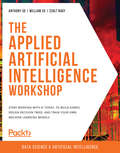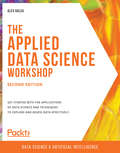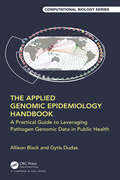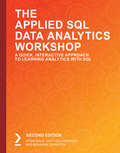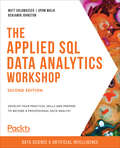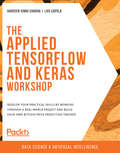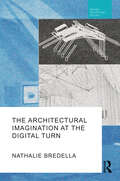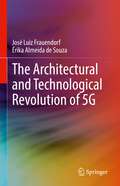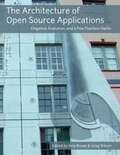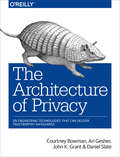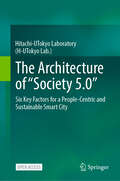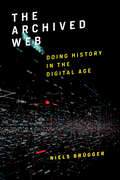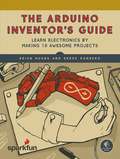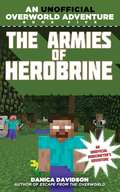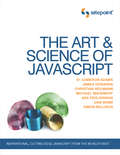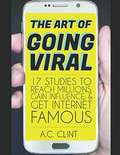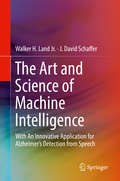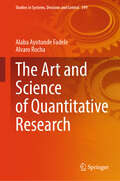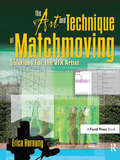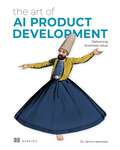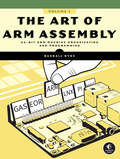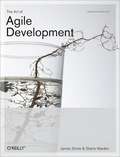- Table View
- List View
The Applied Artificial Intelligence Workshop: Start working with AI today, to build games, design decision trees, and train your own machine learning models
by Zsolt Nagy Anthony So William SoWith knowledge and information shared by experts, take your first steps towards creating scalable AI algorithms and solutions in Python, through practical exercises and engaging activities Key Features Learn about AI and ML algorithms from the perspective of a seasoned data scientist Get practical experience in ML algorithms, such as regression, tree algorithms, clustering, and more Design neural networks that emulate the human brain Book Description You already know that artificial intelligence (AI) and machine learning (ML) are present in many of the tools you use in your daily routine. But do you want to be able to create your own AI and ML models and develop your skills in these domains to kickstart your AI career? The Applied Artificial Intelligence Workshop gets you started with applying AI with the help of practical exercises and useful examples, all put together cleverly to help you gain the skills to transform your career. The book begins by teaching you how to predict outcomes using regression. You'll then learn how to classify data using techniques such as k-nearest neighbor (KNN) and support vector machine (SVM) classifiers. As you progress, you'll explore various decision trees by learning how to build a reliable decision tree model that can help your company find cars that clients are likely to buy. The final chapters will introduce you to deep learning and neural networks. Through various activities, such as predicting stock prices and recognizing handwritten digits, you'll learn how to train and implement convolutional neural networks (CNNs) and recurrent neural networks (RNNs). By the end of this applied AI book, you'll have learned how to predict outcomes and train neural networks and be able to use various techniques to develop AI and ML models. What you will learn Create your first AI game in Python with the minmax algorithm Implement regression techniques to simplify real-world data Experiment with classification techniques to label real-world data Perform predictive analysis in Python using decision trees and random forests Use clustering algorithms to group data without manual support Learn how to use neural networks to process and classify labeled images Who this book is for The Applied Artificial Intelligence Workshop is designed for software developers and data scientists who want to enrich their projects with machine learning. Although you do not need any prior experience in AI, it is recommended that you have knowledge of high school-level mathematics and at least one programming language, preferably Python. Although this is a beginner's book, experienced students and programmers can improve their Python skills by implementing the practical applications given in this book.
The Applied Data Science Workshop: Get started with the applications of data science and techniques to explore and assess data effectively, 2nd Edition
by Alex GaleaDesigned with beginners in mind, this workshop helps you make the most of Python libraries and the Jupyter Notebook's functionality to understand how data science can be applied to solve real-world data problems. Key Features Gain useful insights into data science and machine learning Explore the different functionalities and features of a Jupyter Notebook Discover how Python libraries are used with Jupyter for data analysis Book Description From banking and manufacturing through to education and entertainment, using data science for business has revolutionized almost every sector in the modern world. It has an important role to play in everything from app development to network security. Taking an interactive approach to learning the fundamentals, this book is ideal for beginners. You'll learn all the best practices and techniques for applying data science in the context of real-world scenarios and examples. Starting with an introduction to data science and machine learning, you'll start by getting to grips with Jupyter functionality and features. You'll use Python libraries like sci-kit learn, pandas, Matplotlib, and Seaborn to perform data analysis and data preprocessing on real-world datasets from within your own Jupyter environment. Progressing through the chapters, you'll train classification models using sci-kit learn, and assess model performance using advanced validation techniques. Towards the end, you'll use Jupyter Notebooks to document your research, build stakeholder reports, and even analyze web performance data. By the end of The Applied Data Science Workshop, you'll be prepared to progress from being a beginner to taking your skills to the next level by confidently applying data science techniques and tools to real-world projects. What you will learn Understand the key opportunities and challenges in data science Use Jupyter for data science tasks such as data analysis and modeling Run exploratory data analysis within a Jupyter Notebook Visualize data with pairwise scatter plots and segmented distribution Assess model performance with advanced validation techniques Parse HTML responses and analyze HTTP requests Who this book is for If you are an aspiring data scientist who wants to build a career in data science or a developer who wants to explore the applications of data science from scratch and analyze data in Jupyter using Python libraries, then this book is for you. Although a brief understanding of Python programming and machine learning is recommended to help you grasp the topics covered in the book more quickly, it is not mandatory.
The Applied Genomic Epidemiology Handbook: A Practical Guide to Leveraging Pathogen Genomic Data in Public Health (Chapman & Hall/CRC Computational Biology Series)
by Allison Black Gytis DudasThe Applied Genomic Epidemiology Handbook: A Practical Guide to Leveraging Pathogen Genomic Data in Public Health provides rationale, theory, and implementation guidance to help public health practitioners incorporate pathogen genomic data analysis into their investigations. During the SARS-CoV-2 pandemic, viral whole genome sequences were generated, analyzed, and shared at an unprecedented scale. This wealth of data posed both tremendous opportunities and challenges; the data could be used to support varied parts of the public health response but could be hard for much of the public health workforce to analyze and interpret, given a historical lack of experience working with pathogen genomic data.This book addresses that gap. Structured into eight wide-ranging chapters, this book describes how the overlapping timescales of pathogen evolution and infection transmission enable exploration of epidemiologic dynamics from pathogen sequence data. Different approaches to sampling and genomic data inclusion are presented for different types of epidemiologic investigations. To support epidemiologists in diving into pathogen genomic data analysis, this book also introduces the analytic tools and approaches that are readily used in public health departments and presents case studies to show step-by-step how genomic data are used and evaluated in disease investigations.Despite the breadth of scientific literature that uses pathogen genomic data to investigate disease dynamics, there remains little practical guidance to help applied epidemiologists build their ability to explore epidemiologic questions with pathogen genomic data. This handbook was written to serve as that guide. Including case studies, common methods, and software tools, this book will be of great interest to public health microbiologists or lab directors, bioinformaticians, epidemiologists, health officers, academics, as well as students working in a public health context.
The Applied SQL Data Analytics Workshop: A Quick, Interactive Approach to Learning Analytics with SQL, 2nd Edition
by Benjamin Johnston Upom Malik Matt GoldwasserCut through the noise and get real results with a step-by-step approach to learning about SQL data analysis Key Features Ideal for SQL beginners who are getting started with data analytics for the first time A step-by-step SQL tutorial with exercises and activities that help build key skills Structured to let you progress at your own pace, on your own terms Use your physical print copy to redeem free access to the online interactive edition Book Description You already know that you want to learn data analysis with SQL, and a smarter way to learn is to learn by doing. The Applied SQL Data Analytics Workshop focuses on building up your practical skills so that you can navigate and compose custom reports like an expert data analyst. You'll learn from real examples that lead to real results. Throughout The Applied SQL Data Analytics Workshop, you'll take an engaging step-by-step approach to understand data analytics with SQL. You won't have to sit through any unnecessary theory. You can jump into a single exercise each day if you're short on time, or you can spend an entire weekend tinkering with SQLAlchemy and Python. It's your choice. Learning on your terms, you'll build up and reinforce key skills in a way that feels rewarding. Every physical print copy of The Applied SQL Data Analytics Workshop unlocks access to the interactive edition. With videos detailing all exercises and activities, you'll always have a guided solution. You can also benchmark yourself against assessments, track progress, and receive content updates. You'll even earn a secure credential that you can share and verify online upon completion. It's a premium learning experience that's included with your printed copy. To redeem, follow the instructions located at the start of your book. Fast-paced and direct, The Applied SQL Data Analytics Workshop is the ideal companion for SQL beginners. You'll perform SQL queries like a professional data scientist, learning along the way. This process means that you'll find that your new skills stick, embedded as best practice. A solid foundation for the years ahead. What you will learn Experiment with data analytics using basic and advanced queries Learn data interpretation through descriptive statistics and aggregate functions Export data from outside sources using powerful SQL queries Discover how to work with and manipulate data using SQL joins and constraints Speed up your data analysis workflow by automating tasks and optimizing queries Discover different advanced analytics techniques, including geospatial and text analysis Who this book is for Our goal at Packt is to help you be successful, in whatever it is you choose to do. The Applied SQL Data Analytics Workshop is an ideal tutorial for the beginner who wants to perform data analysis with SQL and is just getting started. Pick up a Workshop today, and let Packt help you develop skills that stick with you for life.
The Applied SQL Data Analytics Workshop: Develop your practical skills and prepare to become a professional data analyst, 2nd Edition
by Benjamin Johnston Upom Malik Matt GoldwasserTake a step-by-step approach to learning SQL data analysis in this interactive workshop that uses fun exercises and activities to make learning data analytics for beginners easy and approachable. Key Features Explore ways to use SQL for data analytics and gain key insights from your data Study advanced analytics, such as geospatial and text analytics Discover ways to integrate your SQL pipelines with other analytics technologies Book Description Every day, businesses operate around the clock and a huge amount of data is generated at a rapid pace. Hidden in this data are key patterns and behaviors that can help you and your business understand your customers at a deep, fundamental level. Are you ready to enter the exciting world of data analytics and unlock these useful insights? Written by a team of expert data scientists who have used their data analytics skills to transform businesses of all shapes and sizes, The Applied SQL Data Analytics Workshop is a great way to get started with data analysis, showing you how to effectively sieve and process information from raw data, even without any prior experience. The book begins by showing you how to form hypotheses and generate descriptive statistics that can provide key insights into your existing data. As you progress, you'll learn how to write SQL queries to aggregate, calculate and combine SQL data from sources outside of your current dataset. You'll also discover how to work with different data types, like JSON. By exploring advanced techniques, such as geospatial analysis and text analysis, you'll finally be able to understand your business at a deeper level. Finally, the book lets you in on the secret to getting information faster and more effectively by using advanced techniques like profiling and automation. By the end of The Applied SQL Data Analytics Workshop, you'll have the skills you need to start identifying patterns and unlocking insights in your own data. You will be capable of looking and assessing data with the critical eye of a skilled data analyst. What you will learn Understand what data analytics is and why it is important Experiment with data analytics using basic and advanced queries Interpret data through descriptive statistics and aggregate functions Export data from external sources using powerful SQL queries Work with and manipulate data using SQL joins and constraints Speed up your data analysis workflow by automating tasks and optimizing queries Who this book is for If you are a database engineer who is looking to transition into analytics or someone who knows SQL basics but doesn't know how to use it to create business insights, then this book is for you.
The Applied TensorFlow and Keras Workshop: Develop your practical skills by working through a real-world project and build your own Bitcoin price prediction tracker
by Luis Capelo Harveen Singh ChadhaCut through the noise and get real results with this workshop for beginners. Use a project-based approach to exploring machine learning with TensorFlow and Keras. Key Features Understand the nuances of setting up a deep learning programming environment Gain insights into the common components of a neural network and its essential operations Get to grips with deploying a machine learning model as an interactive web application with Flask Book Description Machine learning gives computers the ability to learn like humans. It is becoming increasingly transformational to businesses in many forms, and a key skill to learn to prepare for the future digital economy. As a beginner, you'll unlock a world of opportunities by learning the techniques you need to contribute to the domains of machine learning, deep learning, and modern data analysis using the latest cutting-edge tools. The Applied TensorFlow and Keras Workshop begins by showing you how neural networks work. After you've understood the basics, you will train a few networks by altering their hyperparameters. To build on your skills, you'll learn how to select the most appropriate model to solve the problem in hand. While tackling advanced concepts, you'll discover how to assemble a deep learning system by bringing together all the essential elements necessary for building a basic deep learning system - data, model, and prediction. Finally, you'll explore ways to evaluate the performance of your model, and improve it using techniques such as model evaluation and hyperparameter optimization. By the end of this book, you'll have learned how to build a Bitcoin app that predicts future prices, and be able to build your own models for other projects. What you will learn Familiarize yourself with the components of a neural network Understand the different types of problems that can be solved using neural networks Explore different ways to select the right architecture for your model Make predictions with a trained model using TensorBoard Discover the components of Keras and ways to leverage its features in your model Explore how you can deal with new data by learning ways to retrain your model Who this book is for If you are a data scientist or a machine learning and deep learning enthusiast, who is looking to design, train, and deploy TensorFlow and Keras models into real-world applications, then this workshop is for you. Knowledge of computer science and machine learning concepts and experience in analyzing data will help you to understand the topics explained in this book with ease.
The Architects of Toxic Politics in America: Venom and Vitriol
by Kenneth T. WalshThe Architects of Toxic Politics in America: Venom and Vitriol explains the history of poison politics in America by profiling some of the key political “attack dogs” who have shaped the modern landscape.Comparing and contrasting the Trump and Biden presidencies with administrations of the past, the book explains the unique character of the current toxic political moment and the forces that have created it. The book also focuses quite extensively on “non-presidential” architects of toxic politics: other politicians, campaign strategists, activists, and media figures (and a few key figures that have fulfilled two or more of these roles). Drawing on his long career as a journalist specializing in presidential coverage, Kenneth T. Walsh argues that due to the complex, often conflicting nature of American government, the angriest, most decisive voices can command media, voter, and legislative attention and thereby maintain and consolidate power. This results in frustration, alienation, and cynicism—and ultimately, a diminishment of voter participation that can reinforce the vicious cycle and lead to electoral disaster.For anyone interested in politics, media, and the culture of “gotcha” journalism, this book will also be a valuable addition to undergraduate and graduate courses on politics, the presidency, political and media ethics, campaign history and government.
The Architectural Imagination at the Digital Turn (Routledge Research in Design, Technology and Society)
by Nathalie BredellaThe Architectural Imagination at the Digital Turn asks what it means to speak of a "digital turn" in architecture. It examines how architects at the time engaged with the digital and imagined future modes of practice, and looks at the technological, conceptual and economic phenomena behind this engagement. It argues that the adoption of digital technology in architecture was far from linear but depended on complex factors, from the operative logic of the technology itself to the context in which it was used and the people who interacted with it. Creating a mosaic-like account, the book presents debates, projects and publications that changed how architecture was visualized, fabricated and experienced using digital technology. Spanning the university, new media art institutes, ecologies, architectural bodies, fabrication and the city, it re-evaluates familiar narratives that emphasized formal explorations; instead, the book aims to complicate the "myth" of the digital by presenting a nuanced analysis of the material and social context behind each case study. During the 1990s, architects repurposed software and technological concepts from other disciplines and tested them in a design environment. Some architects were fascinated by its effects, others were more critical. Through its discussion on case studies, places and themes that fundamentally influenced discourse formation in the era, this book offers scholars, researchers and students fresh insights into how architecture can engage with the digital realm today.
The Architectural and Technological Revolution of 5G
by José Luiz Frauendorf Érika Almeida de SouzaThe book discusses the evolution of cellular technology, then focusing in on 5G and its architecture and what it means for current engineers. The book first focuses on 4G and how it changed the industry, allowing people to communicate by connecting devices to the internet. The authors detail the emergence of services and applications that have revolutionized communication and continue to impact the daily habits of majority of the world's population. The authors endeavor to tell this story by showing the path taken until the arrival of 5G, detailing how technological and architectural progress evolved in all these years. It is a technical book, but the authors take care to explain in detail each aspect related to technology in order to allow everyone interested in the subject to delve into this important topic.Presents a comprehensive explanation about 4G and 5G architecture, modulation and protocols;Includes a thorough explanation of modern antennas technology and O-RAN;Relevant to technology professionals and students interested in 5G, but with little background in telecommunications;The English translation of this book from its Portuguese original manuscript was done with the help of artificial intelligence (machine translation by the service provider DeepL.com). A subsequent human revision of the content was done by the author.
The Architecture of Open Source Applications: Elegance, Evolution, and a Few Fearless Hacks
by Greg Wilson Amy BrownArchitects look at thousands of buildings during their training, and study critiques of those buildings written by masters. In contrast, most software developers only ever get to know a handful of large programs well—usually programs they wrote themselves—and never study the great programs of history. As a result, they repeat one another's mistakes rather than building on one another's successes. Our goal is to change that. In these two books, the authors of four dozen open source applications explain how their software is structured, and why. What are each program's major components? How do they interact? And what did their builders learn during their development? In answering these questions, the contributors to these books provide unique insights into how they think. If you are a junior developer, and want to learn how your more experienced colleagues think, these books are the place to start. If you are an intermediate or senior developer, and want to see how your peers have solved hard design problems, these books can help you too.
The Architecture of Privacy: On Engineering Technologies that Can Deliver Trustworthy Safeguards
by Courtney Bowman Ari Gesher Elissa Lerner John K Grant Daniel SlateTechnology’s influence on privacy not only concerns consumers, political leaders, and advocacy groups, but also the software architects who design new products. In this practical guide, experts in data analytics, software engineering, security, and privacy policy describe how software teams can make privacy-protective features a core part of product functionality, rather than add them late in the development process.Ideal for software engineers new to privacy, this book helps you examine privacy-protective information management architectures and their foundational components—building blocks that you can combine in many ways. Policymakers, academics, students, and advocates unfamiliar with the technical terrain will learn how these tools can help drive policies to maximize privacy protection.Restrict access to data through a variety of application-level controlsUse security architectures to avoid creating a single point of trust in your systemsExplore federated architectures that let users retrieve and view data without compromising data securityMaintain and analyze audit logs as part of comprehensive system oversightExamine case studies to learn how these building blocks help solve real problemsUnderstand the role and responsibilities of a Privacy Engineer for maintaining your privacy architecture
The Architecture of “Society 5.0”: Six Key Factors for a People-Centric and Sustainable Smart City
by Hitachi-UTokyo LaboratoryThis open access book introduces H-UTokyo Lab’s ideas about the architecture for Society 5.0, including the process and organizational infrastructure for building smart cities that embody the Society 5.0 vision. It introduces six factors critical to the success of efforts to build people-centric sustainable smart cities. Each factor represents something needed to enable a local government to build a smart city, address the local issues, and ensure that these efforts contribute toward a people-centric sustainable society. The book is not only focused on initiatives that use digital innovation but extends beyond technological aspects, it also emphasizes the overall architecture—the general structures and organizational designs that encompass digital initiatives among other things. Through this book, readers get a better understanding of the current status of the smart-city agenda and its future path. The book is designed to serve as a handbook for public officials in national and local government, for businesspeople, for academics, for those in the third sector, and for any other actor involved in this undertaking.
The Archived Web: Doing History in the Digital Age (The\mit Press Ser.)
by Niels Bru¨GgerAn original methodological framework for approaching the archived web, both as a source and as an object of study in its own right.As life continues to move online, the web becomes increasingly important as a source for understanding the past. But historians have yet to formulate a methodology for approaching the archived web as a source of study. How should the history of the present be written? In this book, Niels Brügger offers an original methodological framework for approaching the web of the past, both as a source and as an object of study in its own right. While many studies of the web focus solely on its use and users, Brügger approaches the archived web as a semiotic, textual system in order to offer the first book-length treatment of its scholarly use. While the various forms of the archived web can challenge researchers' interactions with it, they also present a range of possibilities for interpretation. The Archived Web identifies characteristics of the online web that are significant now for scholars, investigates how the online web became the archived web, and explores how the particular digitality of the archived web can affect a historian's research process. Brügger offers suggestions for how to translate traditional historiographic methods for the study of the archived web, focusing on provenance, creating an overview of the archived material, evaluating versions, and citing the material. The Archived Web lays the foundations for doing web history in the digital age, offering important and timely guidance for today's media scholars and tomorrow's historians.
The Arduino Inventor's Guide: Learn Electronics by Making 10 Awesome Projects
by Derek Runberg Brian HuangWith Arduino, you can build any hardware project you can imagine. This open-source platform is designed to help total beginners explore electronics, and with its easy-to-learn programming language, you can collect data about the world around you to make something truly interactive.The Arduino Inventor's Guide opens with an electronics primer filled with essential background knowledge for your DIY journey. From there, you’ll learn your way around the Arduino through a classic hardware entry point—blinking LEDs. Over the course of the book, 11 hands-on projects will teach you how to:–Build a stop light with LEDs–Display the volume in a room on a warning dial–Design and build a desktop fan–Create a robot that draws with a motor and pens–Create a servo-controlled balance beam–Build your own playable mini piano–Make a drag race timer to race toy cars against your friendsEach project focuses on a new set of skills, including breadboarding circuits; reading digital and analog inputs; reading magnetic, temperature, and other sensors; controlling servos and motors; and talking to your computer and the Web with an Arduino. At the end of every project, you’ll also find tips on how to use it and how to mod it with additional hardware or code.What are you waiting for? Start making, and learn the skills you need to own your technology!Uses the Arduino Uno board or SparkFun RedBoard
The Armies of Herobrine: An Unofficial Overworld Adventure, Book Five (Unofficial Overworld Adventure)
by Danica DavidsonThe portal between Minecraft and the real world may have been restored, but Herobrine is still at large-and Stevie knows that a confrontation is inevitable. While Stevie, Alex, and their friends try to awaken humanity to the reality of Herobrine’s threats, the Overworld’s armies prepare for an epic battle.When Herobrine creates his own portal to the human world and releases vicious zombies at the middle school Halloween party, the students are convinced the attack is just an elaborate prank-until the night takes a violent turn. With war breaking out around them, it’s up to Stevie and his friends to defeat Herobrine and restore peace.The epic, world-spanning battle that follows will test friendships, reveal the group’s true allies and their most dangerous foes, and decide the fate not just of the Overworld, but of all humanity.
The Art & Science of JavaScript: Inspirational, Cutting-Edge JavaScript From the World's Best
by Michael Mahemoff Christian Heilmann James Edwards Cameron Adams Ara Pehlivanian Dan Webb Simon WillisonWe've assembled seven of the greatest minds in modern JavaScript to teach you the most inspirational techniques you'll ever use. From creating impressive mashups and stunning, dynamic graphics, to more subtle user-experience enhancements, you're about to be amazed by the true potential of this powerful language.With an all star line-up of authors including James Edwards, Michael Mahemoff, Ara Pehlivanian, Cameron Adams, Dan Webb, Christian Heilmann, and Simon Willison, this superb book will show you how to:Create a slick Google Maps and Flickr mashup.Build your own fully accessible 3D maze.Create stunning vector graphics using the canvas element.Have some fun with draggable and sortable table columns.Give your site some extra personality with client-side badges.Write better code faster using metaprogramming techniques.Become a debugging expert using pro-level Firebug tricks.Presented in full color, all of the books solutions are cross-browser and cross-platform compatible. Best of all, all the code used in the book is available for you to download and experiment with.Who Should Read This Book?This book is targeted at intermediate JavaScript developers who want to take their JavaScript skills to the next level without sacrificing web accessibility or best practice.If you have even a small amount of experience with JavaScript, and are comfortable enough programming in another language such as PHP or Java, you'll be just fine - we'll hold your hand along the way, and all of the code is available for you to download and experiment with on your own.
The Art Of Going Viral: 17 Studies To Reach Millions, Gain Influence, And Get Internet Famous
by A. C. ClintWhy is it that some things EXPLODE online, while others linger in anonymity for years? Why do some things hook our attention, while others flop? Is there a pattern behind how social media captivates us? Viral fame is not just a coincidence. There is an easy-to-learn strategy behind it. Whether your dream is YouTube stardom, or just creating opportunity with a personal brand, Going Viral is your blueprint for digital success. Stand out, get noticed, and captivate online. Going Viral pairs raw human behavioral data with the emotional intelligence of A.C. Clint, a sought-after digital media coach who has worked with Fortune 500 clients from Disney to Nike. Clint has distilled years of research and practical experience to write this manual for content people are wired to share.
The Art and Business of Teaching Yoga (revised): The Yoga Professional’s Guide to a Fulfilling Career
by Amy Ippoliti Taro SmithOriginally published in 2016, The Art and Business of Teaching Yoga immediately became the essential resource for those looking to start or maintain a successful career in yoga. Since then, the landscape has changed. Online yoga and social media are now a crucial part of most teachers’ repertoires. Yoga teachers also face broad cultural shifts, an evolving environmental crisis, and resulting anxiety among students, all of which bring fresh challenges to their leadership and teaching abilities. This expanded edition will help you:• plan dynamic classes, including engaging digital content• build a loyal student base and become more financially stable• optimize your own practice• maintain a marketing plan and develop a unique brand• teach yoga to facilitate ease and inspire creative action in a troubled world
The Art and Science of Machine Intelligence: With An Innovative Application for Alzheimer’s Detection from Speech
by J. David Schaffer Walker H. Land Jr.This volume presents several machine intelligence technologies, developed over recent decades, and illustrates how they can be combined in application. One application, the detection of dementia from patterns in speech, is used throughout to illustrate these combinations. This application is a classic stationary pattern detection task, so readers may easily see how these combinations can be applied to other similar tasks. The expositions of the methods are supported by the basic theory they rest upon, and their application is clearly illustrated. The book’s goal is to allow readers to select one or more of these methods to quickly apply to their own tasks.Includes a variety of machine intelligent technologies and illustrates how they can work togetherShows evolutionary feature subset selection combined with support vector machines and multiple classifiers combinedIncludes a running case study on intelligent processing relating to Alzheimer’s / dementia detection, in addition to several applications of the machine hybrid algorithms
The Art and Science of Quantitative Research (Studies in Systems, Decision and Control #599)
by Alvaro Rocha Alaba Ayotunde FadeleThis book reflects on the insights gained from exploring the key dimensions of quantitative research as outlined in the preceding chapters. Quantitative research, with its emphasis on objectivity, systematic methodologies, and statistical rigor, plays a pivotal role in advancing knowledge across diverse fields. The study began with an introduction to its foundational principles, highlighting its distinct characteristics and relevance. Key conclusions drawn from each chapter are summarized below:In the first chapter, a basic knowledge of quantitative research was presented, with an emphasis on the methodical and organized approach that quantitative research takes to the study of observable events. Quantitative research differs from qualitative research in that it focuses on numerical data, statistical analysis, and objective findings, as opposed to qualitative research, which investigates subjective experiences and meanings. This contrast highlights the crucial role that quantitative approaches play in hypothesis testing and predictive analysis, which makes them very beneficial for academic subjects that need empirical data and findings that can be replicated from experiment to experiment. In the next chapter, we delved further into the fundamental aspects of quantitative research, including its dependence on organized instruments (such as surveys and experiments), the significance of operationalizing variables, and the pursuit of results that can be generalized. When it comes to answering problems that need accuracy, scalability, and statistical validity, quantitative research is an indispensable tool because of these inherent characteristics. At the same time, the chapter brought attention to the attitude of the researcher, which includes taking an objective perspective, reducing prejudice, and adhering to ethical norms. This frame of mind is very necessary in order to guarantee the honesty and dependability of the findings of the investigation.
The Art and Technique of Matchmoving: Solutions for the VFX Artist
by Erica HornungMatchmoving has become a standard visual effects procedure for almost every situation where live action materials and CG get combined. It allows virtual and real scenes that have been composited together to seamlessly appear as though they are from the same perspective. This authoritative step-by-step guide from one of the best matchmovers in the business allows you to master this technique that has been called the foundation upon which all VFX work stands. Author Erica Hornung (sr. matchmover for Lord of the Rings: The Two Towers, Matrix: Revolutions, and more) imparts her techniques, tips, and wisdom from the trenches that will have you matchmoving like a true professional in no time. Lessons in the most popular matchmoving software (Maya, Boujou, and others) are included, as well as tips and techniques for surveying on set, dolly moves, and operating nodal cameras. Individual chapters dedicated to object and character matchmoves show you how to matchmove for shadow casting, adding weapons and other objects, focusing on center of gravity, as well as complete CG character support.The downloadable resources include Quicktime examples of techniques shown in the book, as well as project files that allow you to master these techniques yourself by working alongside the lessons featured in the text.
The Art of 64-Bit Assembly, Volume 1: x86-64 Machine Organization and Programming
by Randall HydeA new assembly language programming book from a well-loved master. Art of 64-bit Assembly Language capitalizes on the long-lived success of Hyde's seminal The Art of Assembly Language.Randall Hyde's The Art of Assembly Language has been the go-to book for learning assembly language for decades. Hyde's latest work, Art of 64-bit Assembly Language is the 64-bit version of this popular text. This book guides you through the maze of assembly language programming by showing how to write assembly code that mimics operations in High-Level Languages. This leverages your HLL knowledge to rapidly understand x86-64 assembly language.This new work uses the Microsoft Macro Assembler (MASM), the most popular x86-64 assembler today. Hyde covers the standard integer set, as well as the x87 FPU, SIMD parallel instructions, SIMD scalar instructions (including high-performance floating-point instructions), and MASM's very powerful macro facilities. You'll learn in detail: how to implement high-level language data and control structures in assembly language; how to write parallel algorithms using the SIMD (single-instruction, multiple-data) instructions on the x86-64; and how to write stand alone assembly programs and assembly code to link with HLL code. You'll also learn how to optimize certain algorithms in assembly to produce faster code.
The Art of AI Product Development: Delivering business value (The Art of)
by Dr. Janna LipenkovaA hands-on guide for delivering value with AI-driven products! Learn how AI can improve content creation, accelerate data analysis, and upgrade process automation.The Art of AI Product Development offers a clear, practical approach to creating products that use AI. It provides real-world guidance on defining your AI strategy, developing useful AI features, and supporting user trust and adoption. Rather than chasing trends, the book focuses on core principles and long-term thinking—foundations that remain relevant as the field evolves. Inside The Art of AI Product Development, you will learn vital skills for the effective use of AI, including: • Identifying market and business opportunities for AI • Gaining an in-depth understanding of modern AI approaches, incl. predictive AI, LLMs, Retrieval-Augmented Generation, and agent systems • Assembling AI solutions that work, without the hype • Efficiently communicating with data scientists and ML engineers • Designing user-friendly AI interfaces that emphasize trust and transparency • Implementing safe, ethical AI with proper governance processes The Art of AI Product Development is written for product managers, tech executives, UX designers, and anyone responsible for the success of an AI-driven product. It introduces a broad spectrum of AI opportunities and case studies from different domains such as marketing, supply chain, and logistics. You&’ll carefully progress from initial design conversations, through to efficient and secure development, and on to deployment and day-to-day management of AI-driven applications. About the technology Integrating AI into your software and processes can create real value for your business and its customers—if you do it right. When you&’re on the hook for delivering AI-enabled products, you&’ll need to spot high-impact opportunities, work effectively with engineers, design user-centric features, avoid common project failures, and manage real-world launches. This book shows you how. About the book The Art of AI Product Development gives you a clear framework, practical tools, and real-world examples to build confidence and succeed with new AI projects—even if you&’re tackling AI for the first time. You&’ll love the practical use cases and end-to-end scenarios from domains such as marketing, supply chain management, and sustainability. What's inside • Ideate, shape, and prioritize AI opportunities • Develop AI systems with techniques such as prompt engineering, RAG, and predictive AI • Communicate with different AI stakeholders and promote AI adoption About the reader Written for software product managers, business-oriented engineers, UX designers, startup founders, and anyone responsible for developing, designing, or marketing AI products. No experience with AI required. About the author Dr. Janna Lipenkova is the founder of an AI and analytics business where she has successfully managed AI projects for world-class companies like BMW, Lufthansa, and Volkswagen. Table of Contents Part 1 1 Creating value with AI-driven products 2 Discovering and prioritizing AI opportunities 3 Mapping the AI solution space Part 2 4 Predictive AI 5 Exploring and evaluating language models 6 Prompt engineering 7 Search and retrieval-augmented generation 8 Fine-tuning language models 9 Automating workflows with agentic AI Part 3 10 AI user experience: Designing for uncertainty 11 AI governance 12 Working with your stakeholders Appendix A AI development toolbox
The Art of ARM Assembly, Volume 1: 64-Bit ARM Machine Organization and Programming
by Randall HydeModern Instructions for 64-Bit ARM CPUsBuilding on Randall Hyde&’s iconic series, The Art of ARM Assembly delves into programming 64-bit ARM CPUs—the powerhouses behind iPhones, Macs, Chromebooks, servers, and embedded systems.Following a fast-paced introduction to the art of programming in assembly and the GNU Assembler (Gas) specifically, you&’ll explore memory organization, data representation, and the basic logical operations you can perform on simple data types. You&’ll learn how to define constants, write functions, manage local variables, and pass parameters efficiently. You&’ll explore both basic and advanced arithmetic operations, control structures, numeric conversions, lookup tables, and string manipulation—in short, you&’ll cover it all. You&’ll also dive into ARM SIMD (Neon) instructions, bit manipulation, and macro programming with the Gas assembler, as well as how to:Declare pointers and use composite data structures like strings, arrays, and unionsConvert simple and complex arithmetic expressions into machine instruction sequencesUse ARM addressing modes and expressions to access memory variablesCreate and use string library functions and build libraries of assembly code using makefilesThis hands-on guide will help you master ARM assembly while revealing the intricacies of modern machine architecture. You&’ll learn to write more efficient high-level code and gain a deeper understanding of software-hardware interactions—essential skills for any programmer working with ARM-based systems.
The Art of Agile Development
by James Shore Shane WardenThe Art of Agile Development contains practical guidance for anyone considering or applying agile development for building valuable software. Plenty of books describe what agile development is or why it helps software projects succeed, but very few combine information for developers, managers, testers, and customers into a single package that they can apply directly. This book provides no-nonsense advice on agile planning, development, delivery, and management taken from the authors' many years of experience with Extreme Programming (XP). You get a gestalt view of the agile development process, including comprehensive guidance for non-technical readers and hands-on technical practices for developers and testers. The Art of Agile Development gives you clear answers to questions such as: How can we adopt agile development? Do we really need to pair program? What metrics should we report? What if I can't get my customer to participate? How much documentation should we write? When do we design and architect? As a non-developer, how should I work with my agile team? Where is my product roadmap? How does QA fit in? The book teaches you how to adopt XP practices, describes each practice in detail, then discusses principles that will allow you to modify XP and create your own agile method. In particular, this book tackles the difficult aspects of agile development: the need for cooperation and trust among team members. Whether you're currently part of an agile team, working with an agile team, or interested in agile development, this book provides the practical tips you need to start practicing agile development. As your experience grows, the book will grow with you, providing exercises and information that will teach you first to understand the rules of agile development, break them, and ultimately abandon rules altogether as you master the art of agile development. "Jim Shore and Shane Warden expertly explain the practices and benefits of Extreme Programming. They offer advice from their real-world experiences in leading teams. They answer questions about the practices and show contraindications - ways that a practice may be mis-applied. They offer alternatives you can try if there are impediments to applying a practice, such as the lack of an on-site customer. --Ken Pugh, Author of Jolt Award Winner, Prefactoring "I will leave a copy of this book with every team I visit." --Brian Marick, Exampler Consulting
